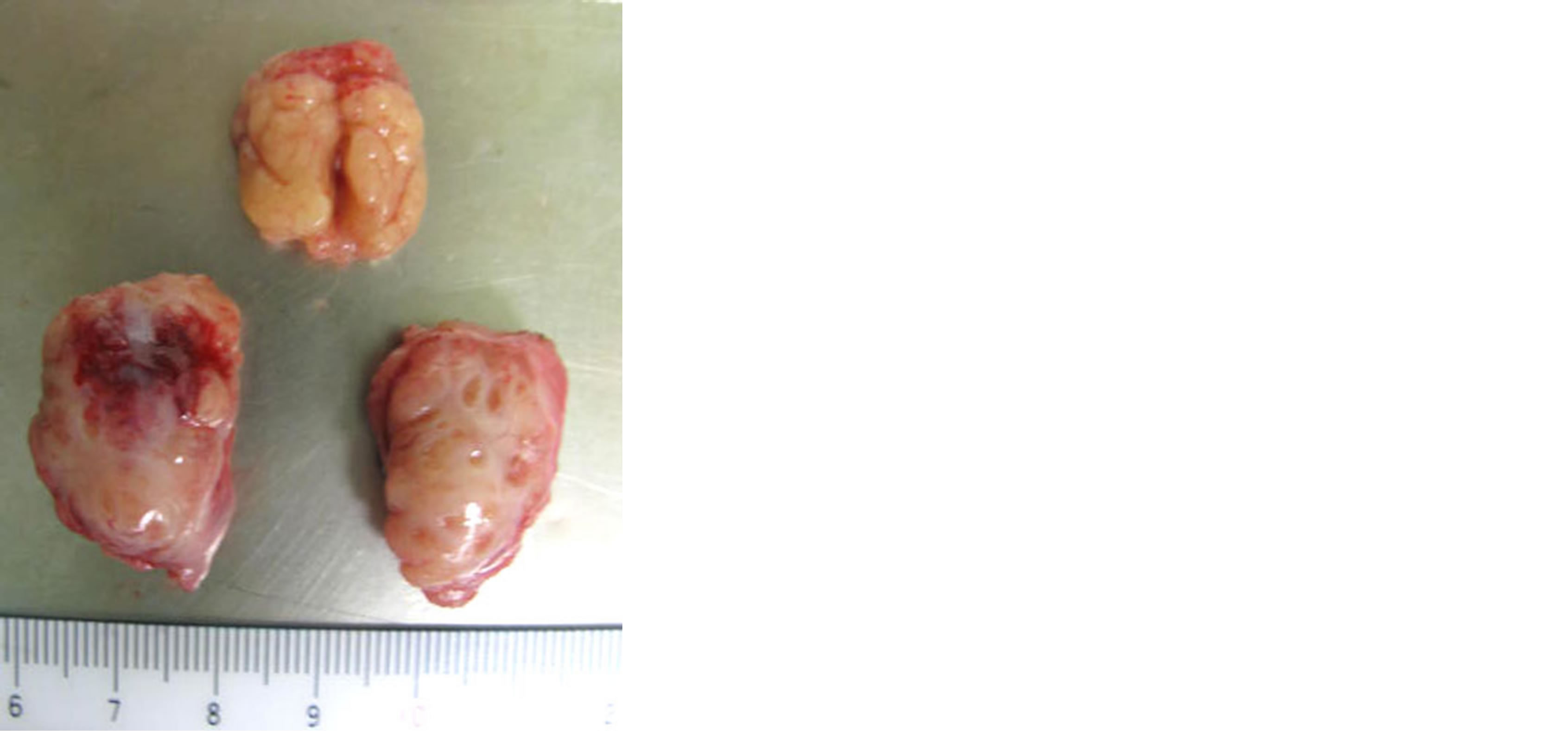International Journal of Clinical Medicine
Vol.5 No.4(2014), Article ID:42770,2 pages DOI:10.4236/ijcm.2014.54024
Specific Gravity of the Tonsil and the Adenoid
Otorhinolaryngology, Mukai Clinic, Kanagawa, Japan.
Email: s-mukai@da2.so-net.ne.jp
Copyright © 2014 Susumu Mukai. This is an open access article distributed under the Creative Commons Attribution License, which permits unrestricted use, distribution, and reproduction in any medium, provided the original work is properly cited. In accordance of the Creative Commons Attribution License all Copyrights © 2014 are reserved for SCIRP and the owner of the intellectual property Susumu Mukai. All Copyright © 2014 are guarded by law and by SCIRP as a guardian.
Received December 23rd, 2013; revised January 20th, 2014; accepted February 10th, 2014
KEYWORDS
Specific Gravity; Adenoid; Tonsil; Adenotonsilectomy; Respiration
ABSTRACT
Purpose: When considering about adeno-tonsillar hypertrophies it is important to know their weights as well as their specific gravities. Subjects and methods: Specific gravities of 344 tonsils and 117 adenoids were measured. Results: Average specific gravities of tonsils and adenoids were 1.08 (SD: 0.0411), 1.12 (SD: 0.574) respectively. Significant difference was observed between two (p < 0.002). Discussion: The palatine tonsils and pharyngeal tonsil or adenoid are in a Waldeyer’s ring. They are thought that they work for lymphatic immune systems. However, there are several differences between tonsil and adenoid. The former has capsule, and increases their weight by growth; on the contrary the latter has no capsule, shrinks by growth. Tonsils are relatively hard mass but adenoids are very soft and easily bleed by touching with cotton swabs via nose. Conclusion: At this study, specific gravity of the adenoid was heavier than that of tonsils. These results suggest that tonsil and adenoid are physiologically different.
1. Introduction
The author studied weights of the tonsils and adenoids for the patients with obstructive sleep apnea-hypopnea patients. Considering about volumes of tonsils, adenoids are only confirmed after detecting their specific gravities. There were no reports found about the specific gravity of tonsil and adenoid.
The author studied specific gravities of both tonsils and adenoids. The results revealed that there was statistical difference about specific gravity between tonsil and adenoid.
2. Materials and Methods
Materials were tonsils and adenoids that were gained by patients that had tonsillar hypertrophies and/or adenoid vegetations. Age distribution of tonsillar hypertrophy was from 2 years 11 months old to 48 years old. Total of 344 tonsils were measured from 172 cases. Age distributions were from 2 years 11 months to 14 years 11 month. Total of 117 adenoids was measured from 117 cases with adenoid vegetations.
Specific gravities of specimens were calculated by employing Archimedean principles. The weight of a specimen (Tg) was measured first by a digital scale (YUYAMA CS-300S, Tokyo, minimum scale is 0.01 g). Next weight of water filled beaker (Wo) was measured, then weight of beaker (Ws) was measured that a lined specimen was pendent into the water that did not touch the bottom of it. The specific gravity (Sg) of a specimen was calculated as follows;

3. Result
The average specific gravity of 344 tonsils was 1.08 (SD with 0.041). That of 117 adenoids was 1.12 (SD with 0.057). There was significant difference between tonsil and adenoid (p < 0.002) (Table 1).
4. Discussion
The specific gravity of tonsil was 1.08 (SD; 0.041) and that of adenoid was 1.17 (SD; 0.057). The tissue density of adenoid was higher than that of tonsils. Although tonsil and adenoid belong to the Waldeyer’s ring there are several differences between two. Those are as follows:
1) Macroscopic view of tonsil is whitish dark red. That of adenoid is yellowish red [1] (Figure 1).
2) Adenoid bleed easy when touch it by a swab via nose. Tonsil is not.
3) Tonsil is hard and springy like a rubber. Adenoid is soft like berry of sea urchin.
4) Tonsil is covered with stratified squamous epithetlium. Adenoid consists with stratified columnar epithetlium [2].

Table 1. Specific gravity of the tonsil and adenoid.
 Curetted adenoid (above) (weight; 2.0 g, Specific gravity (sg); 1.09), Tonsils (below) (weight; (right): 4.1 g, sg; 1.07, (left); 3.3 g, sg; 1.06).
Curetted adenoid (above) (weight; 2.0 g, Specific gravity (sg); 1.09), Tonsils (below) (weight; (right): 4.1 g, sg; 1.07, (left); 3.3 g, sg; 1.06).
Figure 1. Tonsils (below) and curetted adenoid vegetation (above) (4y3m, male).
5) Tonsil has crypts. Adenoid has not.
6) Weight of tonsil increases with growth [3,4]. The maximum of the adenoid is around five years old. Adenoid shrinks after it [5-7].
In addition with those differences sited above, this study revealed that the specific gravity of adenoid is heavier than that of tonsil.
These differences suggest that tonsil and adenoid is physiologically different organ.
REFERENCES
- L. Michaels and H. B. Hellquist, “The Palatine Tonsil, Development; Normal Anatomy, Histology; Inflamatory Diseases,” In: L. Michaels, Ed., Ear, Nose and Throat Histopathology, 2nd Edition, Springer, London, 2001, pp. 261-289. http://dx.doi.org/10.1007/978-1-4471-0235-9_28
- L. Michaels and H. B. Hellquist, “Normal Anatomy and Histology; Adenoids; Infectins; Developmental Lesions. In: L. Michaels, Ed., Ear, Nose and Throat Histopathology, 2nd Edition, Springer, London, 2001, pp. 259-263. http://dx.doi.org/10.1007/978-1-4471-0235-9_23
- C. S. Handelman and G. Osborne, “Growth of Nasopharyngeal Adenoid Development from One to Eighteen Years,” The Angle Orthodontist, Vol. 46, 1976, pp. 243- 459.
- S. Mukai, “Tonsils Increases in Weight during Growth, Moreover There Are Gender Differeces. Optimumtime of Tonsilectomy Is between Two to Four (In Japanese),” Nihon Zetuyuchakushogakkaishi, Annals of the Ankyloglossia with Deviation of the Epiglottis and Larynx, Vol. 17, 2011, pp. 19-26.
- S. Mukai, “Weight Changings of the Curetted Adenoid Vegetations (In Japanese),” Nihon Zetuyuchakushogakkaishi; Annals of the Ankyloglossia with Deviation of the Epiglottis and Larynx, Vol. 17, 2011, pp. 27-31.
- S. Mukai, “Vicissitude of Curetted Adenoid Vegetations,” IJCM, Vol. 4, 2013, pp. 251-256. http://www.scirp.org/journal/ijcm
- S. Mukai, “Tonsils Increase in Weight during Growth,” IJCM, Vol. 4, 2013, pp. 222-227. http://www.scirp.org/journal/ijcm

